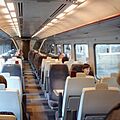British Rail Class 158 facts for kids
Quick facts for kids British Rail Class 158 "Express Sprinter" |
|
|---|---|

Northern Rail unit 158791
|
|
| In service | Since 1989 |
| Manufacturer | BREL |
| Built at | Derby Works |
| Family name | Sprinter |
| Constructed | 1989—1992 |
| Number built | 182 trainsets |
| Number in service | 170 trainsets |
| Formation | 2 or 3 cars per trainset |
| Operator(s) | Arriva Trains Wales East Midlands Trains First Great Western First ScotRail Northern Rail South West Trains |
| Specifications | |
| Car body construction | Welded aluminium |
| Car length | 22.16m |
| Width | 2.7 |
| Articulated sections | Flexible diaphragm within and between units |
| Maximum speed | 90 mph (140 km/h) |
| Weight | 37.8 t (37.2 long tons; 41.7 short tons) or 38.5 t (37.9 long tons; 42.4 short tons) per car |
| Traction system | DMU |
| Prime mover(s) | Cummins NTA855R1, Perkins 2006-TWH or Cummins NTA855R3 |
| Power output | 350 hp (260 kW) or 400 hp (300 kW) per engine |
| Transmission | Voith T211rz or T211rzz hydraulic and Gmeinder GM 190 final drive. |
| Braking system(s) | Pneumatic, Disc |
| Safety system(s) | AWS, TPWS |
| Track gauge | 1,435 mm (4 ft 8 1⁄2 in) |
The British Rail Class 158 is a special type of train called an Express Sprinter. It's a diesel multiple unit (DMU), which means it runs on diesel fuel and has its engines built right into the passenger cars. These trains were made for British Rail between 1989 and 1992. They were built by a company called BREL at their Derby Works in England.
The Class 158s were designed to replace older diesel trains and trains pulled by separate locomotives. They helped modernize train travel in the UK. A very similar train is the Class 159. Class 158 trains are still used today on many routes that don't have electric power lines, like services from Exeter St David's to London Waterloo.
Contents
What is a Class 158 Train?
The Class 158 is a type of train that carries passengers. It's known as a "Sprinter" because it's designed for faster regional services. These trains are made up of either two or three connected carriages. Each carriage has its own engine, so the train doesn't need a separate engine car. This makes them efficient for stopping at many stations.
Why Were They Built?
These trains were built to improve train services across the UK. They replaced older, less comfortable trains. They also took over routes that used to be run by trains pulled by locomotives. This made journeys smoother and often quicker for passengers.
How Many Were Made?
A total of 182 Class 158 train sets were built. Most of them are still in service today, with about 170 sets running on the tracks. They have been a very successful and long-lasting part of the UK's railway system.
Where Do Class 158s Operate?
Class 158 trains are used by several different train companies across the UK. They are important for connecting towns and cities on non-electrified lines.
- Arriva Trains Wales: These trains serve routes in Wales.
- East Midlands Trains: They operate in the East Midlands region of England.
- First Great Western: You can find them on routes in the West of England.
- First ScotRail: They are a key part of the railway network in Scotland.
- Northern Rail: These trains serve many routes across Northern England.
- South West Trains: They operate services in the South West of England.
Train Features and Design
The Class 158 trains are built with a welded aluminium body. This makes them strong yet relatively light. Each car is about 22 meters long. They can reach a top speed of 90 miles per hour (about 145 kilometers per hour).
Engines and Power
Each Class 158 train car has powerful diesel engines. These engines can produce between 350 and 400 horsepower. They use a special hydraulic transmission system to transfer power to the wheels. This allows the trains to accelerate well and maintain speed.
Safety Systems
These trains are fitted with important safety systems. These include the AWS and the TPWS. These systems help the driver by providing warnings and automatically applying brakes if needed. This helps keep everyone on board safe.
Images for kids
-
The interior of a Northern Rail refurbished Class 158 (First Refurbishment)
-
British Rail 158819 at Bristol Temple Meads in 1993
-
A First ScotRail class 158 at Glasgow Central in 2013
-
Unrefurbished Arriva Trains Wales (ATW) 158823 at Barmouth in 2009. Class 158s are required on Cambrian Line services as they are the only Transport for Wales trains fitted with the ERTMS signalling used on the line.
-
Great Western Railway 158956 at Bristol Temple Meads in July 2016
-
Northern Rail 158904 in Metro livery at Doncaster on 3 November 2007
-
An Arriva Trains Wales Class 158 at Bristol
-
158954 at Newport in the current First Great Western livery
-
158725 on the Far North Line on 11 April 2008, whilst forming a First ScotRail serice to Wick
-
Northern Rail 158752 at Doncaster on 3 November 2007
-
158789 at Bristol Temple Meads on 7 December 2005, having formed a South West Trains service from London Waterloo


















